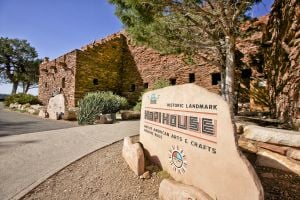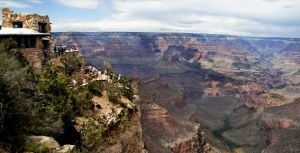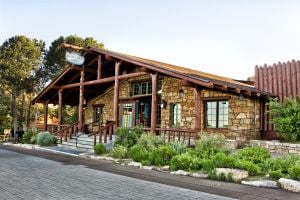Please select an arrival date.
Please select a departure date.
Please select a return date.
Make Your
Reservation
Book Your Adventure
Sights to See
Please select an arrival date.
Please select a departure date.
Please select a return date.
Make Your
Reservation
Book Your Adventure
See More with a Rim Tour
Go where automobiles can’t, to scenic overlooks reserved for our special Grand Tour. See more and learn more from amazing vantage points you otherwise wouldn’t be able to experience. The tour lasts approximately 1.5 hours and is narrated by a knowledgeable guide. You can add a rim tour to any train trip or package.
Mary Colter
Mary Elizabeth Jane Colter was Chief Architect and Decorator for the Fred Harvey Company/Santa Fe Railroad. During the first half of the 20th century, Colter designed buildings where park visitors could rest, stay, eat and shop. Using local materials to create rustic buildings in the Southwestern style, she built many of her most unique structures along the South Rim of the Grand Canyon.
Nights at the Canyon
Take your time and explore the park by staying the night. Grand Canyon Railway makes it possible to spend the night in Grand Canyon National Park while conveniently working with our train schedule. Book a “Canyon Limited” or “Canyon Limited Plus” package which includes round-trip train travel, plus one night in the park, along with additional nights at the Grand Canyon Railway Hotel in Williams. Travel just like they did at the turn of the 20th century, and take the train in and out of the park.
Right to the Rim
The train delivers you just steps from the rim, arriving at the historic Grand Canyon Depot built in 1910. It is the only operating log depot in the United States. Just steps above the depot sits the El Tovar Hotel and the rim. The railroad built both structures so they made it a convenient distance from each other and the rim for arriving train passengers. Most of the historic buildings along the rim are walking distance from the train depot.
Sights & Activities
The Historic District at the South Rim began to take shape as stage coaches loaded with passengers began arriving to view the Grand Canyon. The arrival of the Grand Canyon Railway in 1901 provided a comfortable and affordable alternative to the stage coach, and quickly became the preferred mode of travel to the South Rim. The stagecoach companies were not happy with this development, but the guests arrived rested and ready to explore the newly famous gorge. The Historic District evolved and grew as tourism increased, and remains the center of activity at the South Rim today. There are many buildings of historical significance that visitors will find interesting during their visit to the South Rim. The canyon views from this area are stunning and offer a different perspective from those at Mather Point.
El Tovar Hotel
The historic El Tovar Hotel, the premier lodging facility at the Grand Canyon, first opened its doors in 1905 and was most recently renovated in 2005. In the past, the hotel has hosted such luminaries as Theodore Roosevelt, Albert Einstein, Western author Zane Grey, and many others. Today, El Tovar is a Registered National Historic Landmark, and retains its elegant charm. Located on the Canyon rim, it features a fine dining room (open for breakfast, lunch, and dinner), lounge, and curio shop with newsstand, and offers its guests Concierge, turn-down and room service.
Once described as “the most expensively constructed and appointed log house in America,” El Tovar Hotel was commissioned by the Santa Fe Railroad in 1902. It cost $250,000 to construct and was considered by many to be the most elegant hotel west of the Mississippi. Electric lights were powered by the hotel’s own coal-fired generator. It had its own greenhouse for fresh fruits and vegetables. A chicken house supplied fresh eggs for guests, and even fresh milk was supplied by the hotel’s own dairy herd. Inside El Tovar were a barbershop, amusement room, club room, solarium, art and music rooms, and a large dining room with large picture windows overlooking the canyon. The porch on the north side is thought to date back to the 1950s, when the dining room was enlarged and the cocktail lounge was added.
Hopi House
 Opened January 1, 1905, as the first curio shop at the Grand Canyon, Hopi House was designed by renowned architect Mary Elizabeth Jane Colter, one of the first American architects to appreciate the beauty and utility of Native American design. The design of the structure was meant to reflect that of a typical adobe pueblo used by the Hopi Indians of old Oraibi. (In fact, over the years there were Hopis who lived and worked there, and entertained guests with nightly dances on the dance platform to the north.)
Opened January 1, 1905, as the first curio shop at the Grand Canyon, Hopi House was designed by renowned architect Mary Elizabeth Jane Colter, one of the first American architects to appreciate the beauty and utility of Native American design. The design of the structure was meant to reflect that of a typical adobe pueblo used by the Hopi Indians of old Oraibi. (In fact, over the years there were Hopis who lived and worked there, and entertained guests with nightly dances on the dance platform to the north.)
Constructed mainly by Hopi Indians, Hopi House is a multi-story structure of stone and adobe masonry with ceilings on the inside thatched with successive layers of saplings and timbers. It also features wall niches, corner fireplaces, and adobe walls typical of Hopi pueblos. Now a National Historic Landmark, Hopi House has been recently renovated and offers authentic Native American arts and crafts to visitors for purchase.
Lookout Studio
 Lookout Studio was designed in 1914 by Mary E.J. Colter as a gift shop and lookout point for the Fred Harvey Company. Perched on the South Rim, it blends exceptionally well with its natural setting. The building was designed with native stone and an irregular roofline to blend into the rim of the Grand Canyon. Like Hopi House, it was designed to imitate the stone dwellings of the Pueblo Indians of the Southwest. The chimney was made of irregular stones, which allowed soil and debris to collect between the cracks. Plants found a niche for growing, which further blended the building into its surroundings. A lounge was inside the studio with a fireplace and an art room where postcards and artwork were for sale.
Lookout Studio was designed in 1914 by Mary E.J. Colter as a gift shop and lookout point for the Fred Harvey Company. Perched on the South Rim, it blends exceptionally well with its natural setting. The building was designed with native stone and an irregular roofline to blend into the rim of the Grand Canyon. Like Hopi House, it was designed to imitate the stone dwellings of the Pueblo Indians of the Southwest. The chimney was made of irregular stones, which allowed soil and debris to collect between the cracks. Plants found a niche for growing, which further blended the building into its surroundings. A lounge was inside the studio with a fireplace and an art room where postcards and artwork were for sale.
Nowadays, Lookout Studio still sells photography and books related to the Grand Canyon, rock and fossil specimens, traditional souvenirs, books and photographic prints. Two lookout points are open in good weather. It is located a short walk west of historic Bright Angel Lodge. Open year-round and hours vary seasonally.
Kolb Brothers Studio
Once the home of early Grand Canyon photographers the Kolb brothers, the Kolb Studio features changing art exhibits displayed in the auditorium throughout the year. It was built by brothers Ellsworth and Emery Kolb from 1904 to 1926, and is now included in the National Register of Historic Places and operated by Grand Canyon Association who offer tours of the studio’s private residence.
The Kolb brothers started a business photographing parties going down the Bright Angel Trail. Because water supplies were limited on the rim of the Canyon, they would photograph the mule passengers then run four-and-a-half miles to Indian Garden where they had set up a photographic lab. Water was available here for processing the film. They then returned to the rim of the Canyon with the processed pictures ready for the mule passengers on their return. The bookstore and auditorium are open to the public, and the studio is located in the Village Historic District, at the Bright Angel trailhead. Open year-round and hours vary seasonally.
Bright Angel Lodge
 Built in 1935, Bright Angel Lodge has a natural, rustic character, and has always been a popular place to stay and the center of South Rim activity. Designed by famed architect Mary E.J. Colter, the concept of Bright Angel Lodge was unique for park visitors throughout the west. Its mission was to provide moderately priced accommodations for tourists with moderate incomes. It followed the general theme of the El Tovar Hotel, boasting curio shops, a restaurant, and an open-framed lobby with peeled log supports. Colter also decorated the lobby with various styles of period hats including Pancho Villa’s sombrero.
Built in 1935, Bright Angel Lodge has a natural, rustic character, and has always been a popular place to stay and the center of South Rim activity. Designed by famed architect Mary E.J. Colter, the concept of Bright Angel Lodge was unique for park visitors throughout the west. Its mission was to provide moderately priced accommodations for tourists with moderate incomes. It followed the general theme of the El Tovar Hotel, boasting curio shops, a restaurant, and an open-framed lobby with peeled log supports. Colter also decorated the lobby with various styles of period hats including Pancho Villa’s sombrero.
Now a Registered National Historic Landmark, Bright Angel Lodge features a lounge with two large picture windows framing the canyon. Inside the lounge is the famous 10-foot-high geologic fireplace designed by Colter, and representing the rocks and order of strata inside the canyon. The top of the fireplace is constructed of Kaibab Limestone found on the rim of the canyon, with each stone carefully selected from the strata inside the canyon and packed out by mule. Located just a few feet from the canyon rim, Bright Angel Lodge is the check-in point for the world-famous Grand Canyon Mule Rides.
Buckey O’Neill Cabin
Next to Bright Angel Lodge is Buckey O’Neill Cabin, the oldest continuously standing structure on the rim. It was built in the 1890s by William Owen O’Neill, who was more well-known as “Buckey.” He acquired the name by “bucking the odds” in the card game faro.
Buckey O’Neill was born in Missouri and moved to Arizona in 1879. He became an author, journalist, miner, politician and judge. His prospecting ventures eventually led him to a copper deposit near Anita, about 14 miles south of what is now Grand Canyon Village. Like other prospectors who followed him at the Canyon, the cost of shipping the ore kept mining unprofitable. He eventually sold his land to the Santa Fe and Grand Canyon Railway Co., leading the way to train service to the South Rim. O’Neill became one of Teddy Roosevelt’s rough riders and lost his life in the Spanish American War before the rail line was ever completed in 1901.
International Dark-Sky Association
International Dark-Sky Association (IDA) works to educate and advocate for the reduction of light pollution to protect nocturnal wildlife, reduce carbon emissions, and improve our quality of life and connection to the night sky.
 IDA’s International Dark Sky Parks program works with public lands to help them identify and install responsible lighting, develop nighttime educational programs for visitors, and conserve the dark for nocturnal wildlife. The Grand Canyon was designated as a provisional International Dark Sky Park in 2016.
IDA’s International Dark Sky Parks program works with public lands to help them identify and install responsible lighting, develop nighttime educational programs for visitors, and conserve the dark for nocturnal wildlife. The Grand Canyon was designated as a provisional International Dark Sky Park in 2016.